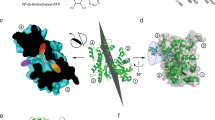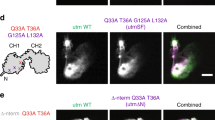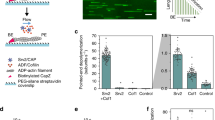Abstract
When tagged with a fluorescent protein, actin is not fully functional1, so the LifeAct peptide fused to a fluorescent protein is widely used to localize actin filaments in live cells2. However, we find that these fusion proteins have many concentration-dependent effects on actin assembly in vitro and in fission yeast cells. mEGFP–LifeAct inhibits actin assembly during endocytosis as well as assembly and constriction of the cytokinetic contractile ring. Purified mEGFP–LifeAct and LifeAct–mCherry bind actin filaments with Kd values of ∼10 μM. LifeAct–mCherry can promote actin filament nucleation and either promote or inhibit filament elongation. Both separately and together, profilin and formins suppress these effects. LifeAct–mCherry can also promote or inhibit actin filament severing by cofilin. These concentration-dependent effects mean that caution is necessary when overexpressing LifeAct fusion proteins to label actin filaments in cells. Therefore, we used low micromolar concentrations of tagged LifeAct to follow assembly and disassembly of actin filaments in cells. Careful titrations also gave an estimate of a peak of ∼190,000 actin molecules (∼500 μm) in the fission yeast contractile ring. These filaments shorten from ∼500 to ∼100 subunits as the ring constricts.
This is a preview of subscription content, access via your institution
Access options
Subscribe to this journal
Receive 12 print issues and online access
$209.00 per year
only $17.42 per issue
Buy this article
- Purchase on Springer Link
- Instant access to full article PDF
Prices may be subject to local taxes which are calculated during checkout





Similar content being viewed by others

References
Doyle, T. & Botstein, D. Movement of yeast cortical actin cytoskeleton visualized in vivo. Proc. Natl Acad. Sci. USA 93, 3886–3891 (1996).
Riedl, J. et al. Lifeact: a versatile marker to visualize F-actin. Nat. Methods 5, 605–607 (2008).
Cooper, J. A., Walker, S. B. & Pollard, T. D. Pyrene actin: documentation of the validity of a sensitive assay for actin polymerization. J. Muscle Res. Cell Motil. 4, 253–262 (1983).
Amann, K. J. & Pollard, T. D. Direct real-time observation of actin filament branching mediated by Arp2/3 complex using total internal reflection fluorescence microscopy. Proc. Natl Acad. Sci. USA 98, 15009–15013 (2001).
Wu, J. Q. & Pollard, T. D. Counting cytokinesis proteins globally and locally in fission yeast. Science 310, 310–314 (2005).
Chen, Q., Nag, S. & Pollard, T. D. Formins filter modified actin subunits during processive elongation. J. Struct. Biol. 177, 32–39 (2012).
Gerisch, G. & Weber, I. Cytokinesis without myosin II. Curr. Opin. Cell Biol. 12, 126–132 (2000).
Carvalho, A., Desai, A. & Oegema, K. Structural memory in the contractile ring makes the duration of cytokinesis independent of cell size. Cell 137, 926–937 (2009).
Murthy, K. & Wadsworth, P. Myosin-II-dependent localization and dynamics of F-actin during cytokinesis. Curr. Biol. 15, 724–731 (2005).
Zhou, M. & Wang, Y. L. Distinct pathways for the early recruitment of myosin II and actin to the cytokinetic furrow. Mol. Biol. Cell. 19, 318–326 (2008).
Chang, F., Drubin, D. & Nurse, P. cdc12p, a protein required for cytokinesis in fission yeast, is a component of the cell division ring and interacts with profilin. J. Cell Biol. 137, 169–182 (1997).
Aizawa, H., Sameshima, M. & Yahara, I. A green fluorescent protein-actin fusion protein dominantly inhibits cytokinesis, cell spreading, and locomotion in Dictyostelium. Cell Struct. Funct. 22, 335–345 (1997).
Burkel, B. M., von Dassow, G. & Bement, W. M. Versatile fluorescent probes for actin filaments based on the actin-binding domain of utrophin. Cell Motil. Cytoskeleton 64, 822–832 (2007).
Kaksonen, M., Sun, Y. & Drubin, D. G. A pathway for association of receptors, adaptors, and actin during endocytic internalization. Cell 115, 475–487 (2003).
Sirotkin, V., Berro, J., Macmillan, K., Zhao, L. & Pollard, T. D. Quantitative analysis of the mechanism of endocytic actin patch assembly and disassembly in fission yeast. Mol. Biol. Cell. 21, 2894–2904 (2010).
Wu, J. Q., Kuhn, J. R., Kovar, D. R. & Pollard, T. D. Spatial and temporal pathway for assembly and constriction of the contractile ring in fission yeast cytokinesis. Dev. Cell 5, 723–734 (2003).
Huang, J. et al. Nonmedially assembled F-actin cables incorporate into the actomyosin ring in fission yeast. J. Cell. Biol. 199, 831–847 (2012).
Coffman, V. C., Nile, A. H., Lee, I. J., Liu, H. & Wu, J. Q. Roles of formin nodes and myosin motor activity in Mid1p-dependent contractile-ring assembly during fission yeast cytokinesis. Mol. Biol. Cell. 20, 5195–5210 (2009).
Drenckhahn, D. & Pollard, T. D. Elongation of actin filaments is a diffusion-limited reaction at the barbed end and is accelerated by inert macromolecules. J. Biol. Chem. 261, 12754–12758 (1986).
Andrianantoandro, E., Blanchoin, L., Sept, D., McCammon, J. A. & Pollard, T. D. Kinetic mechanism of end-to-end annealing of actin filaments. J. Mol. Biol. 312, 721–730 (2001).
Courtemanche, N. & Pollard, T. D. Interaction of profilin with the barbed end of actin filaments. Biochemistry 52, 6456–6466 (2013).
Goode, B. L. & Eck, M. J. Mechanism and function of formins in the control of actin assembly. Annu. Rev. Biochem. 76, 593–627 (2007).
Paul, A. S. & Pollard, T. D. Review of the mechanism of processive actin filament elongation by formins. Cell Motil. Cytoskeleton 66, 606–617 (2009).
Kovar, D. R., Harris, E. S., Mahaffy, R., Higgs, H. N. & Pollard, T. D. Control of the assembly of ATP- and ADP-actin by formins and profilin. Cell 124, 423–435 (2006).
Kovar, D. R., Kuhn, J. R., Tichy, A. L. & Pollard, T. D. The fission yeast cytokinesis formin Cdc12p is a barbed end actin filament capping protein gated by profilin. J. Cell Biol. 161, 875–887 (2003).
Chen, Q. & Pollard, T. D. Actin filament severing by cofilin is more important for assembly than constriction of the cytokinetic contractile ring. J. Cell Biol. 195, 485–498 (2011).
Chen, Q. & Pollard, T. D. Actin filament severing by cofilin dismantles actin patches and produces mother filaments for new patches. Curr. Biol. 23, 1154–1162 (2013).
Andrianantoandro, E. & Pollard, T. D. Mechanism of actin filament turnover by severing and nucleation at different concentrations of ADF/cofilin. Mol. Cell 24, 13–23 (2006).
Chen, Q., Courtemanche, N. & Pollard, T. D. Aip1 promotes actin filament severing by cofilin and regulates constriction of the cytokinetic contractile ring. J. Biol. Chem. 290, 2289–2300 (2015).
Courtemanche, N., Gifford, S. M., Simpson, M. A., Pollard, T. D. & Koleske, A. J. Abl2/Abl-related gene stabilizes actin filaments, stimulates actin branching by actin-related protein 2/3 complex, and promotes actin filament severing by cofilin. J. Biol. Chem. 290, 4038–4046 (2015).
Elam, W. A., Kang, H. & De La Cruz, E. M. Competitive displacement of cofilin can promote actin filament severing. Biochem. Biophys. Res. Commun. 438, 728–731 (2013).
Gandhi, M., Achard, V., Blanchoin, L. & Goode, B. L. Coronin switches roles in actin disassembly depending on the nucleotide state of actin. Mol. Cell 34, 364–374 (2009).
McGough, A., Pope, B., Chiu, W. & Weeds, A. Cofilin changes the twist of F-actin: implications for actin filament dynamics and cellular function. J. Cell Biol. 138, 771–781 (1997).
Prochniewicz, E., Janson, N., Thomas, D. D. & De la Cruz, E. M. Cofilin increases the torsional flexibility and dynamics of actin filaments. J. Mol. Biol. 353, 990–1000 (2005).
Picco, A., Mund, M., Ries, J., Nedelec, F. & Kaksonen, M. Visualizing the functional architecture of the endocytic machinery. Elife 4, e04535 (2015).
Schroeder, T. E. The contractile ring. II. Determining its brief existence, volumetric changes, and vital role in cleaving Arbacia eggs. J. Cell. Biol. 53, 419–434 (1972).
Kanbe, T., Kobayashi, I. & Tanaka, K. Dynamics of cytoplasmic organelles in the cell cycle of the fission yeast Schizosaccharomyces pombe: three-dimensional reconstruction from serial sections. J. Cell. Sci. 94, 647–656 (1989).
Kamasaki, T., Osumi, M. & Mabuchi, I. Three-dimensional arrangement of F-actin in the contractile ring of fission yeast. J. Cell. Biol. 178, 765–771 (2007).
Arasada, R. & Pollard, T. D. Contractile ring stability in S. pombe depends on F-BAR protein Cdc15p and Bgs1p transport from the Golgi complex. Cell Rep. 8, 1533–1544 (2014).
Cao, W., Goodarzi, J. P. & De La Cruz, E. M. Energetics and kinetics of cooperative cofilin-actin filament interactions. J. Mol. Biol. 361, 257–267 (2006).
McCormick, C. D., Akamatsu, M. S., Ti, S. C. & Pollard, T. D. Measuring affinities of fission yeast spindle pole body proteins in live cells across the cell cycle. Biophys. J. 105, 1324–1335 (2013).
Huxley, H. E. & Brown, W. The low-angle x-ray diagram of vertebrate striated muscle and its behavior during contraction and rigor. J. Mol. Biol. 30, 383–434 (1967).
Acknowledgements
The research reported in this publication was supported by the National Institute of General Medical Sciences of the National Institutes of Health under award number R01GM026338. The content is solely the responsibility of the authors and does not necessarily represent the official views of the National Institutes of Health. The authors thank C. Lamoureux, J. Johnson and C. McGuinness for carrying out preliminary experiments for this project.
Author information
Authors and Affiliations
Contributions
N.C., Q.C. and T.D.P. designed the experiments. N.C. performed the biochemistry experiments. Q.C. performed the experiments in yeast. N.C., Q.C. and T.D.P. analysed the data. N.C., Q.C. and T.D.P. wrote the paper.
Corresponding author
Ethics declarations
Competing interests
The authors declare no competing financial interests.
Integrated supplementary information
Supplementary Figure 2 Lifeact-mCherry does not affect the time course of spontaneous actin assembly, but decreases the critical concentration.
(a, b) Normalized time courses of spontaneous assembly of (a) 1.5 μM and (b) 4 μM actin monomers (20% pyrene-labelled) in the absence and presence of a range of concentrations of Lifeact-mCherry. Bulk assembly assays were repeated in 3 independent experiments. (c) Pyrene-actin fluorescence following overnight incubation in polymerization conditions in the absence (black) or presence (red) of 1.5 μM Lifeact-mCherry. Data sets were not normalized and were repeated in 3 independent experiments. Lines are linear fits to the data. (d) Unpolymerized actin as a function of the concentration of Lifeact-mCherry. Samples of 3 μM actin were polymerized with a range concentrations of Lifeact-mCherry. After pelleting filaments supernatant fractions were run on SDS-PAGE, stained with Coomassie blue and band intensities analysed using ImageJ. Data represent 1 out of 3 independent experiments. (e) Dependence of the concentration of additional nucleated filaments required to increase the polymerization rate three-fold on the time it takes each filament to anneal. Concentrations of nuclei were calculated using the length-dependent annealing rate measured by Andrianantoandro et al. 20 and assuming that nucleated filaments elongate with normal rate constants (that is, k+ = 12.9 μM−1 s−1, k− = 1.3 s−1) before annealing together. This experiment demonstrates that subnanomolar to low nanomolar concentrations of nucleated filaments are sufficient to increase the elongation rate of growing filament ends. Data represent the results of a single simulation, which was performed once.
Supplementary Figure 3 Fits to Lifeact-mCherry binding data in the presence of 30 μM Hs cofilin and to barbed end elongation rates.
(a) Binding of a range of Lifeact-mCherry concentrations to 3 μM actin filaments in the presence of 30 μM Hs cofilin (same data as Fig. 4c, which was produced from 3 independent experiments). Pellets were run on SDS-PAGE and band intensities were corrected for molecular weight to determine molar ratios of Lifeact-mCherry to actin. The band intensities were fit with a standard bimolecular binding curve (black dashed line, Kd = 114 μM) and a cooperative binding curve (red line). The solid line is a fit of the binding equation to the Lifeact-mCherry data (Kd = 67 μM and cooperativity factor ω = 8.8). (b) Barbed end elongation rates of actin filaments polymerized in the presence of 0.5 μM actin monomers and micromolar concentrations of Lifeact-mCherry (same data as Fig. 5b, which was produced from 4 independent experiments). Data were normalized with respect to the elongation measured in 100 μM Lifeact-mCherry and fit with a bimolecular binding curve (red line).
Supplementary Figure 4 Comparison of two methods to count the maximum number of mEGFP-Lifeact in contractile rings.
The graph compares counts of peak numbers of mEGFP-Lifeact in 51 cells with the segmentation method on the X-axis and the patch subtraction method on the Y -axis. The red line is the best linear fit of the data (R2 = 0.71). The mEGFP-Lifeact counts are about 50% higher with the patch subtraction method owing to actin filaments in whiskers and cables adjacent to the rings. Data were pooled across 6 independent experiments.
Supplementary information
Supplementary Information
Supplementary Information (PDF 393 kb)
Rights and permissions
About this article
Cite this article
Courtemanche, N., Pollard, T. & Chen, Q. Avoiding artefacts when counting polymerized actin in live cells with LifeAct fused to fluorescent proteins. Nat Cell Biol 18, 676–683 (2016). https://doi.org/10.1038/ncb3351
Received:
Accepted:
Published:
Issue Date:
DOI: https://doi.org/10.1038/ncb3351
This article is cited by
-
Actin polymerisation and crosslinking drive left-right asymmetry in single cell and cell collectives
Nature Communications (2023)
-
LILAC: enhanced actin imaging with an optogenetic Lifeact
Nature Methods (2023)
-
Loss of p53 function promotes DNA damage-induced formation of nuclear actin filaments
Cell Death & Disease (2023)
-
Actin in action
Nature Methods (2023)
-
A functional family of fluorescent nucleotide analogues to investigate actin dynamics and energetics
Nature Communications (2021)


